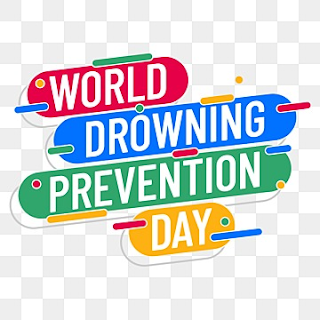World Drowning Prevention Day
“I wish I had carried a life jacket while sailing with you. You swam away, and here I am drowning in the infinite ocean.”- Simran Dhawale.
About 71 percent of the Earth's surface is covered by water. Most of us live on an island yet, many of us are unable to swim. We enjoy going to the beach or river, however, only a few of us can swim. Swimming is a survival skill which we should all make the effort to acquire. As the global heat wave continues to ravish many societies, more and more people especially youngsters will be heading to the beach, unfortunately, many of them are unable to swim and will probably get into difficulty. Every drowning is preventable. Drowning is the process of experiencing respiratory impairment from submersion/immersion in liquid; outcomes are classified as death, morbidity and no morbidity. The United Nations (UN) states every year, an estimated 236,000 people drown, making drowning a major public health problem worldwide. It is estimated that almost 650 deaths occur daily from drowning; 26 every hour. Drowning is the silent epidemic of preventable deaths. Drowning is one of the leading causes of death globally for children and young people aged 1-24 years. Drowning is the 3rd leading cause of unintentional injury death, accounting for 7% of all injury-related deaths. The global burden of death from drowning is felt in all economies and regions, however: low and middle-income countries account for over 90% of unintentional drowning deaths; over half of the world's drowning occurs in the WHO Western Pacific Region and WHO South-East Asia Region; drowning death rates are highest in the WHO Western Pacific Region, and are 27-32 times higher than those seen in the United Kingdom or Germany, respectively. In 2017 over 110,000 people died from drowning in Commonwealth countries. The Commonwealth is made up of 54 independent countries that work together to pursue common goals which promote development, democracy and peace. The combined population is 2.4 billion, of which more than 60% are aged 29 years or under. Estimated number of fatal drowning in Commonwealth countries in the Caribbean and Americas in 2017: Number 1 Canada 325, 2. Guyana 55, 3. Trinidad and Tobago 47. 4. Jamaica 32, 5. The Bahamas 26, 6. Belize 26, 7. Barbados 11, 8. Saint Lucia 10, 9. Saint Vincent and the Grenadines 8, 10. Grenada 7, 11. Dominica 4, 12. Antigua and Barbuda 4. The fatal drowning rate was 4.6 per 100,000 per year. Over one third (37%) of global drowning deaths 37% occurred in Commonwealth countries. 51% of fatal drowning in Commonwealth countries occurred among children and adolescents (0-19 years). The World Health Organization (WHO) reports more than 90% of drowning deaths occur in low- and middle-income countries, with children under the age of five at highest risk. These deaths are frequently linked to daily, routine activities, such as bathing, collecting water for domestic use, travelling over water on boats or ferries, and fishing. The impacts of seasonal or extreme weather events including monsoons are also a frequent cause of drowning. According to the WHO most of these deaths are preventable, through evidence-based, low-cost solutions, such as: installing barriers controlling access to water, providing safe places away from water such as crèches for pre-school children with capable childcare, teaching swimming, water safety and safe rescue skills, training bystanders in safe rescue and resuscitation, setting and enforcing safe boating, shipping and ferry regulations, improving flood risk management. Additionally, one can also contact the local Young Men's/Women's Christian Association (YMCA/YWCA) and sign up for swimming classes. In more advanced societies such as Spain lifeguard drones are being used to save those who are in need.
The drone has the capability, if needed, to deploy two flotation devices that inflate on contact with the water and can be immediately used by the potential victim. Its second function is to clearly identify where the victim is located. We are required to use wisdom and as such it is advisable only to swim in areas where lifeguards are visible. World Drowning Prevention Day, is observed annually on 25 July. This international day serves as an opportunity to highlight the tragic and profound impact of drowning on families and communities and to offer life-saving solutions to prevent it. All stakeholders, governments, UN agencies, civil society organizations, the private sector, academia and individuals are invited to mark World Drowning Prevention Day by producing related advocacy materials, hosting a global launch event and supporting national and local activities in countries and communities around the world. At the country level, WHO has worked with Ministries of Health in some low- and middle-income countries to prevent drowning through the use of barriers controlling access to water and the establishment of day care centres for pre-school children. In addition, WHO has also funded research in low-income countries exploring priority questions related to drowning prevention. At the regional level, WHO organizes training programmes and convenes workshops to draw together representatives of governments, non-governmental organizations (NGOs) and UN agencies working on drowning prevention.
This year's theme will be “Do one thing to prevent drowning”. This theme invites stakeholders to take one firm action to push forward drowning prevention, something that all we can do at any time and at any level. This global advocacy event serves as an opportunity to highlight the tragic and profound impact of drowning on families and communities and offer life-saving suggestions.
In the words of Atticus, she was drowning with rocks around her feet and the world stood by in life boats.
Wayne Campbell is an educator and social commentator with an interest in development policies as they affect culture and or gender issues.
waykam@yahoo.com
@WayneCamo
©
#WorldDrowningPreventionDay #DrowningPrevention



Comments
Post a Comment